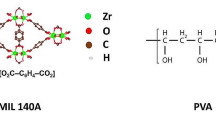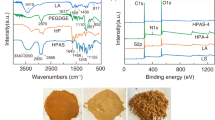Abstract
Mesoporous poly (acrylic acid)/SiO2 (PAA/SiO2) composite nanofiber membranes functionalized with mercapto groups were fabricated by a sol-gel electrospinning method, and their adsorption capacity for indigo carmine was investigated. The membranes were characterized by scanning electron microscopy (SEM), transmission electron microscopy (TEM), Fourier transform infrared spectroscopy (FTIR), Raman spectroscopy, x-ray powder diffraction (XRD), and nitrogen adsorption–desorption measurement. SEM and TEM observation results showed that the PAA/SiO2 fibers had diameters between 400–800 nm and mesopores with an average pore size of 3.88 nm. The specific surface area of the mesoporous nanofiber membranes was 514.89 m2/g. The characteristic peaks for mercapto group vibration in FTIR and Raman spectra demonstrated that the mercapto groups have been incorporated into the silica skeleton. The adsorption isotherm data of indigo carmine on the membranes fit well with Redlich–Peterson model, and the maximum adsorption capacity calculated was 523.11 mg/g. It was found that the removal rate of indigo carmine by the membranes reached a maximum of 98% in 90 min and the adsorption kinetics followed a pseudo-second-order model. The high adsorption capacity of PAA/SiO2 nanofiber membrane makes it a promising adsorbent for indigo carmine removal from the wastewater.











Similar content being viewed by others
References
A. Walcarius, C. Delacote, Anal. Chim. Acta 547, 3 (2005)
S.J. Wu, F.T. Li, Y.N. Wu, R. Xu, G.T. Li, Chem. Commun. 46, 1694 (2010)
B.A. Allo, A.S. Rizkalla, K. Mequanint, Langmuir 26, 18340 (2010)
Y.Z. Wang, Q.B. Yang, G.Y. Shan, C. Wang, J.S. Du, S.G. Wang, Y.X. Li, X.S. Chen, X.B. Jing, Y. Wei, Mater. Lett. 59, 3046 (2005)
Z.T. Zhu, L.F. Zhang, S. Smith, H. Fong, Y.G. Sun, D. Gosztola, Synth. Met. 159, 1454 (2009)
B. Kim, H. Park, S.H. Lee, W.M. Sigmund, Mater. Lett. 59, 829 (2005)
L.L. Wu, X.Y. Yuan, J. Sheng, J. Membr. Sci. 250, 167 (2005)
J. Bai, Y.X. Li, M.Y. Li, S.G. Wang, C.Q. Zhang, Q.B. Yang, Appl. Surf. Sci. 254, 4520 (2008)
M.S.P.D. Lima, M.S. Freire, J.L.C. Fonseca, M.R. Pereira, Carbohydr. Res. 344, 1709 (2009)
Z.M. Huang, Y.Z. Zhang, M. Kotaki, S. Ramakrishna, Compos. Sci. Technol. 2223, 63 (2003)
S. Srivastava, R. Sinha, D. Roy, Aquat. Toxicol. 66, 319 (2004)
X.M. Xue, F.T. Li, Microporous Mesoporous Mater. 116, 116 (2008)
H. Yang, R. Xu, X.M. Xue, F.T. Li, G.T. Li, J. Hazard. Mater. 152, 690 (2008)
S.J. Wu, F.T. Li, R. Xu, S.H. Wei, G.T. Li, J. Nanopart. Res. 12, 2111 (2009)
W. Deligeer, Y.W. Gao, S. Asuha, Appl. Surf. Sci. 257, 3524 (2011)
S.K. Bajpai, S. Shrivastava, J. Appl. Polym. Sci. 119, 2525 (2011)
K.V. Kumar, J. Hazard. Mater. 137, 1538 (2006)
Y.S. Ho, G.M. Kay, Process Biochem. 34, 451 (1999)
Acknowledgements
The work was supported by Ministry of Science and Technology Ministry (2009BAC62B03, CU08-20), Science and Technology Commission of Shanghai Municipality (10230712300), and the State Key Laboratory of Pollution Control and Resource Reuse, China (No. PCRRY08001).
Author information
Authors and Affiliations
Corresponding author
Rights and permissions
About this article
Cite this article
Xu, R., Jia, M., Li, F. et al. Preparation of mesoporous poly (acrylic acid)/SiO2 composite nanofiber membranes having adsorption capacity for indigo carmine dye. Appl. Phys. A 106, 747–755 (2012). https://doi.org/10.1007/s00339-011-6697-1
Received:
Accepted:
Published:
Issue Date:
DOI: https://doi.org/10.1007/s00339-011-6697-1




